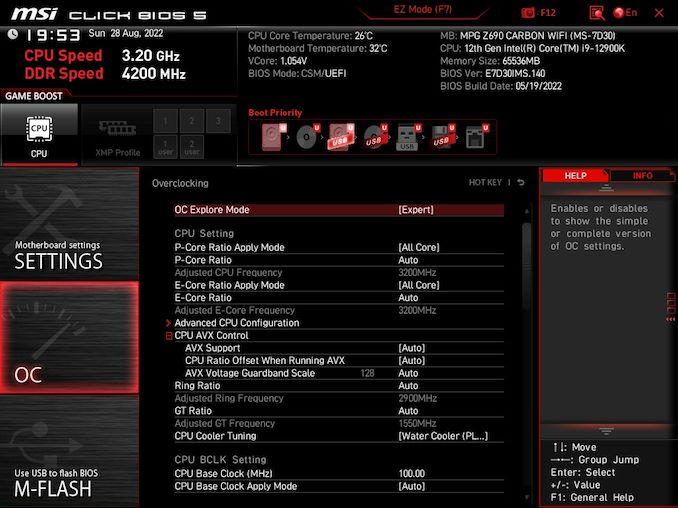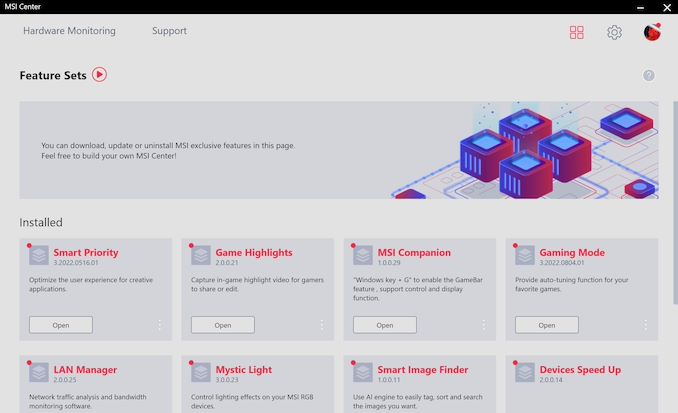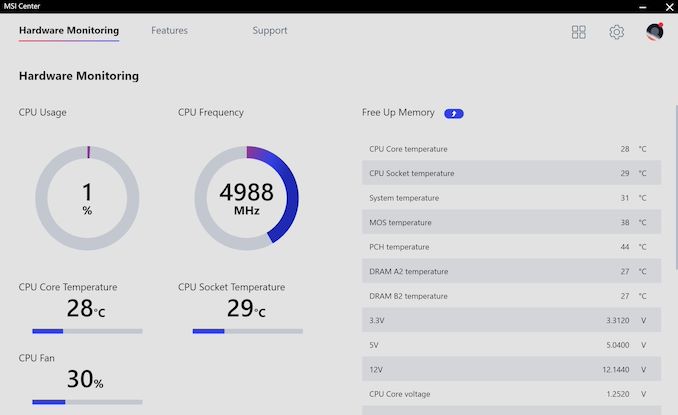The MSI MPG Z690 Carbon WIFI (DDR5) Motherboard Review: A Decent Mid-Ranged Z690
by Gavin Bonshor on September 8, 2022 8:00 AM ESTBIOS
As we've seen across numerous of MSI's motherboards over recent years, its firmware of choice is Click BIOS 5. This is useful for keeping uniformity and familiarity for users consistently sticking with MSI models over multiple generations, including both Intel and AMD. The Click BIOS 5 firmware uses a primarily black background, with red highlights and white and grey text. MSI also includes two modes for users of varying experiences with firmware, an EZ mode for novice users and an advanced mode for the more experienced.
Accessing the board's firmware can be done by pressing either the Del or F2 key during system POST. For the first POST, users will be guided to the EZ mode, which features a list of one-click solutions for enabling things like X.M.P memory profiles, disabling or enabling TPM 2.0, and MSI's EZ LED control. In the center panel of the EZ mode is a list of information on the selected component which can be achieved by clicking on the appropriate component from the list on the left-hand side.
Users can access the advanced mode by pressing the F7 key, and this opens up a whole host of customizations on both hardware and chipset levels. The biggest and by far the area with the most options available to tweak is the OC section, where users can overclock the processor, memory, and even the integrated graphics on supported chips. MSI includes a wide variety of overclocking options, including P-Core and E-Core ratio overclocking, BCLK (base clock) adjustment, CPU AVX core offsetting, and CPU voltage options.
For memory, users can simply enable X.M.P profiles on compatible memory, or manually overclock memory by adjusting the frequency, selecting the desired Intel Gear Mode (1:1, 1:2, or 1:4), as well as fine-tune memory latencies with tonnes of primary, secondary, and tertiary latencies available to select from. MSI also allows users to select between three cooling profiles, which will determine the level of CPU power enabled based on the type of cooling being used. This includes a boxed cooler (stock) with a 241 W PL1/2 limit, a tower air cooler with a limit of 288 W, and a water cooler setting that essentially removes any power limitations (4096 W).
MSI's Click BIOS 5 firmware is intuitive, and it has plenty of options for both novice and advanced users too. As we've mentioned, we've used numerous MSI boards with Click BIOS 5 over the last couple of years, and we've had no issues with navigation, USB input device recognition, or any instabilities while testing with this board.
Software
Another familiar element we've seen with MSI's motherboards over the last year is a more streamlined and uniform software package being offered. At least for Z690, MSI has amalgamated all of its usual software applications such as Mystic Light, LAN Manager, MSI Companion, True Color, and its Hardware Monitor all into one easy-to-navigate MSI Center application.
Looking at the MSI Center software, it acts as a central hub for all of MSI's included software applications. This includes functions such as Live Update where users can download and update the systems drivers and applications to the latest versions over an internet connection. Another software application is Mystic Light which allows users to customize the integrated and external RGB devices for a uniform or custom-themed aesthetic.
The software also comes with an integrated hardware monitor which keeps tabs on multiple sensors across the board including the CPU itself, the LGA 1700 socket, power delivery, and memory slots. Users can also monitor and track various voltages in real-time including CPU VCore, CPU Aux, and DRAM voltages.
Overall MSI's software package has plenty for users to sink their teeth into, although MSI hasn't included any overclocking software with its models of late. This is likely due to Intel and AMD both having their own software for users to download, which has actually been getting better year on year. This includes Intel's Extreme Tuning Utility (XTU) and AMD's Ryzen Master software which both work really well.
The only downside to the software is that users looking to make auditory adjustments will need to download the associated Realtek software directly from the Microsoft Store, although MSI does provide the drivers on the USB flash drive included with the accessories.


























17 Comments
View All Comments
Gich - Thursday, September 8, 2022 - link
Those prices are insane.Mid-range? Full-theft more like it.
Threska - Thursday, September 8, 2022 - link
$350-400 is the new normal. It's like complaining eggs are no longer a quarter for a dozen (1930).shabby - Thursday, September 8, 2022 - link
No it's not, that's like saying a $500 cpu is middle of the pack.Samus - Thursday, September 8, 2022 - link
$400 isn't normal. I've never spent more than $250 on a motherboard (and that was the Asus P6T X58 Deluxe almost 15 years ago)Mainstream Z690 boards are ~$200. You get diminishing returns beyond that, especially if you don't plan to overclock. Most people would be better off with the $250 MSI Tomahawk Z690 over the MPG Z690 as they are virtually identical and the $100-$150 price difference can be better allocated on other components such as CPU or GPU.
Paying twice as much for a motherboard is like paying twice as much for RAM, the cost:benefit is among the worst of any other component.
Duwelon - Thursday, September 8, 2022 - link
Has anyone else noticed that the cheapest boards are generally ugly but very expensive boards are generally cleaner looking and match commonly sought after color schemes? Been a trend for awhile now.Duwelon - Thursday, September 8, 2022 - link
I mean this "Carbon" skin that MSI is using probably costs them less than $5 compared to their cheapest option. People avoid the cheaper options out of vanity when they have 95% or more of the same features, and motherboard makers know this, hence they make their lowest end SKUs butt ugly.thestryker - Friday, September 9, 2022 - link
FWIW I was thinking similarly as I had that same board, but adding inflation in that board would be around $350 today so it's right in line with these offerings. This *does* constitute the new midrange, but I do agree that you need to evaluate what you're doing with your system and pick off of that since many cheaper boards are great.Emyof4D - Saturday, September 10, 2022 - link
I might be misinterpreting, but think the point was that it was hardly a "mid-range" board at the time. X58 was already the enthusiast version of the chips, so even a "basic" X58 board was fairly high end. A more comparable board might be a MSI P55-GD80 for socket 1156, which was about 175 back when it launched.timecop1818 - Saturday, September 10, 2022 - link
Lol no. And this board is a fucking scam. MSI's own PRO Z690-A is < $200 almost anywhere and has exactly the same feature set as this scam, minus dumb RGB shite. $200 is about the max I'd pay for a Z-series board, and 100-150 max for B-series. Anything > $400 is ridiculous.Samus - Monday, September 12, 2022 - link
The VRM's are slightly different on the Pro (14 phase) but the Tomahawk and the MPG both have 18+1 (the MPG is technically 20 phase I guess -_-) and the Tomahawk is $150 less. So if you want high boost for prolonged periods on a hungry chip both boards will probably perform identically.The Pro-A, however, would probably be the board I get because I don't see myself getting a K CPU anyway. They are all so ridiculously fast and most demanding loads only need momentary boost clocks (like extracting a RAR or loading a game) that any Z690 board will have a decent enough VRM package to comply before the power stage heats up and scales the clock back. In the case of the boards with really cheap components (like the Gigabyte Aorus Ultra Lite with the 10+2+1) you might never hit Boost 2.0 even though they claim its for a laughably high 105A while many 14+ phase can't even do 60A. Potential power delivery doesn't equal constant power delivery.